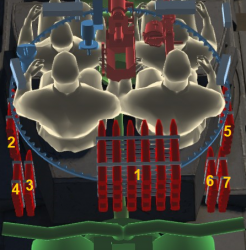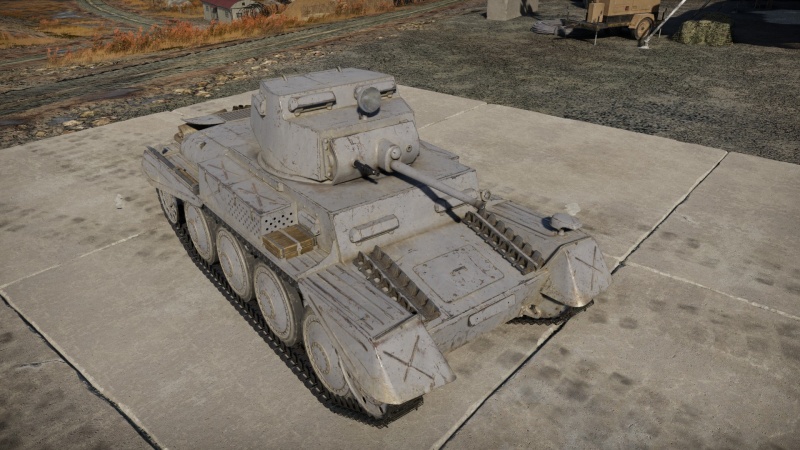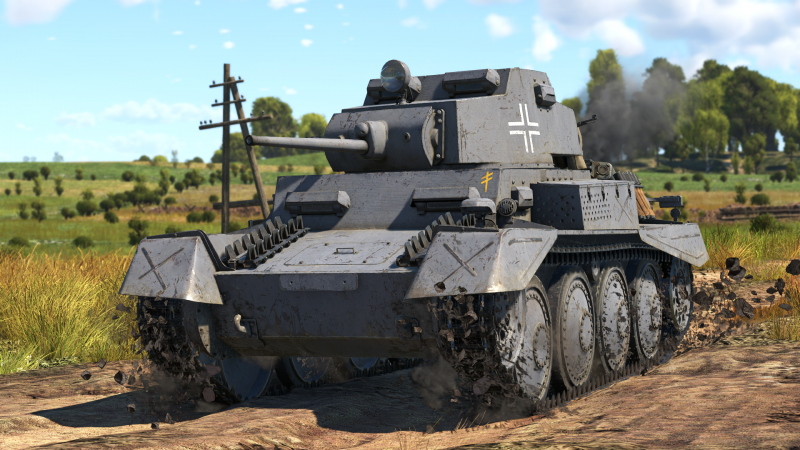Difference between revisions of "Pz.38(t) n.A."
Colok76286 (talk | contribs) (Undo revision 167901 by U140241225 (talk)) |
|||
| Line 142: | Line 142: | ||
You should use the Pzgr. 34(t) as your main round, as it can reliably penetrate most, if not all, of the tanks of your BR. It has a better post-penetration damage than the APCR if you can penetrate the target because it has high-explosive filler. Always carry a few PzGr 40 rounds additionally to the APC shell. The APCR has the most penetration out of all the available shells, so it should be carried, just in case you meet a heavily armoured target. | You should use the Pzgr. 34(t) as your main round, as it can reliably penetrate most, if not all, of the tanks of your BR. It has a better post-penetration damage than the APCR if you can penetrate the target because it has high-explosive filler. Always carry a few PzGr 40 rounds additionally to the APC shell. The APCR has the most penetration out of all the available shells, so it should be carried, just in case you meet a heavily armoured target. | ||
| − | ; '''Enemies worth noting''' | + | ; '''Enemies worth noting'''<nowiki>:</nowiki> |
;* Regardless of distance, the Pz.38 n.A. will have trouble penetrating heavily armoured enemies: the [[Valentine I]], the [[B1 bis]] or [[B1 ter|ter]], the [[Matilda III]], the [[Churchill I]] and the [[M4A3 (105)]]. | ;* Regardless of distance, the Pz.38 n.A. will have trouble penetrating heavily armoured enemies: the [[Valentine I]], the [[B1 bis]] or [[B1 ter|ter]], the [[Matilda III]], the [[Churchill I]] and the [[M4A3 (105)]]. | ||
Revision as of 16:50, 1 August 2023
| This page is about the German light tank Pz.38(t) n.A.. For other versions, see Pz.38(t) A and Pz.38(t) F. |
Contents
Description
The Pz.38(t) n.A. is a rank I German light tank with a battle rating of 2.3 (AB/RB/SB). It was introduced in Update "La Royale".
General info
Survivability and armour
The Pz.38(t) n.A. has similarly bad survivability as the Pz.35(t) and Pz.38(t) A. It boasts 30 mm of armour on the front hull and turret front. This makes it frontally vulnerable to most guns, staying out of sight is key to not get destroyed by the enemy.
Armour type:
- Rolled homogeneous armour (hull, turret, cupola)
- Cast homogeneous armour (gun mantlet, sights)
| Armour | Front (Slope angle) | Sides | Rear | Roof |
|---|---|---|---|---|
| Hull | 30 mm | 25 mm Top 25 mm Bottom |
20 mm | 10 - 20 mm |
| Turret | 30 - 50 mm Turret front 50 mm Gun mantlet |
12 - 25 mm | 12 - 20 mm | 12 mm |
| Cupola | 20 mm | 25 mm | 20 mm | 12 mm |
Notes:
- Suspension wheels, tracks and torsion bars are 15 mm thick.
- Add-on tracks on the front hull are 15 mm thick.
- Mudguards are 4 mm thick.
Mobility
As a light tank, the Pz.38(t) A accelerates decently and is able to reach its top speed of 46 km/h in a dozen of seconds. Braking happens quickly but the hull wobbles for a full second afterwards.The narrow tracks will grant you a decent mobility on hard terrain (solid ground, roads) but poor mobility on soft terrain (mud, snow, sand). Light obstacles (fences and bushes) are not a problem but medium to large obstacles (posts, trees, concrete blocks and parked vehicles) will reduce your mobility: avoid them.
| Game Mode | Max Speed (km/h) | Weight (tons) | Engine power (horsepower) | Power-to-weight ratio (hp/ton) | |||
|---|---|---|---|---|---|---|---|
| Forward | Reverse | Stock | Upgraded | Stock | Upgraded | ||
| Arcade | 68 | 10 | 11.5 | _,___ | 420 | __.__ | 36.52 |
| Realistic | 61 | 9 | _,___ | 220 | __.__ | 19.13 | |
Modifications and economy
Armaments
Main armament
The KwK38(t) gun offers a below-average penetration power at its battle rating. Its average muzzle velocity allows for a rather flat firing trajectory but the accuracy drop is noticeable from 700 m distance and becomes a handicap over 1,000 m. The rotation speed of the turret is slow but average compared to other tanks at the same rank or battle rating. Elevation and depression angles of the gun are important, allowing you to fire from unusual positions (behind a ridge, on a slope, etc.). The shoulder-stop stabilizer allows for a good targeting but at very slow speed (under 8 km/h). The reload time of the gun is short, in line with other tanks equipped with a 37 mm cannon at the same BR. Your recoil is non-existent: coupled with the short reload time, this allows you to make rain shells on a target. The average penetration power of the APC shot and the important loss of penetration of the APCR above 500 m are the biggest weaknesses of the Pz.38 n.A. regarding its armament. This will force you to get close to enemy tanks to have a chance at penetrating them, nullifying your increased armour advantage in the process.
| 37 mm KwK38(t) | Turret rotation speed (°/s) | Reloading rate (seconds) | |||||||||||
|---|---|---|---|---|---|---|---|---|---|---|---|---|---|
| Mode | Capacity | Vertical | Horizontal | Stabilizer | Stock | Upgraded | Full | Expert | Aced | Stock | Full | Expert | Aced |
| Arcade | 60 | -10°/+25° | ±180° | Shoulder | 18.45 | __._ | __._ | __._ | 26.35 | 4.29 | _.__ | _.__ | 3.33 |
| Realistic | 9.8 | __._ | __._ | __._ | 14.0 | ||||||||
Ammunition
The ammunition available to the Pz.38 n.A. allows for engaging all types of targets:
- Pzgr. 34(t): APC; a shell with explosive filler but an average penetration power. It should be the main ammunition used in battle.
- PzGr 40: APCR; a composite round with the best penetration but no explosive filler and that will only penetrate flat vertical surfaces. Pack a few of these shells to use against heavily armoured foes that the Pzgr. 34(t) can't penetrate. This round however becomes fairly ineffective above 500 m distance.
- Pzgr.(t) umg.: APC; a shell offering a penetration power similar to the Pzgr. 34(t) while being a bit faster and slightly lighter.
| Penetration statistics | |||||||
|---|---|---|---|---|---|---|---|
| Ammunition | Type of warhead |
Penetration @ 0° Angle of Attack (mm) | |||||
| 10 m | 100 m | 500 m | 1,000 m | 1,500 m | 2,000 m | ||
| Pzgr. 34(t) | APC | 62 | 59 | 45 | 32 | 23 | 17 |
| PzGr. 40 | APCR | 86 | 77 | 47 | 26 | 14 | 8 |
| Pzgr.(t) umg. | APC | 61 | 58 | 44 | 31 | 22 | 15 |
| Shell details | ||||||||||||
|---|---|---|---|---|---|---|---|---|---|---|---|---|
| Ammunition | Type of warhead |
Velocity (m/s) |
Projectile mass (kg) |
Fuse delay (m) |
Fuse sensitivity (mm) |
Explosive mass (TNT equivalent) (g) |
Ricochet | |||||
| 0% | 50% | 100% | ||||||||||
| Pzgr. 34(t) | APC | 741 | 0.85 | 1.2 | 9 | 22.1 | 48° | 63° | 71° | |||
| PzGr. 40 | APCR | 1,020 | 0.37 | - | - | - | 66° | 70° | 72° | |||
| Pzgr.(t) umg. | APC | 750 | 0.82 | 1.2 | 9 | 22.1 | 48° | 63° | 71° | |||
Ammo racks

| Full ammo |
1st rack empty |
2nd rack empty |
3rd rack empty |
4th rack empty |
5th rack empty |
6th rack empty |
Visual discrepancy |
|---|---|---|---|---|---|---|---|
| 60 | 37 (+23) | 31 (+29) | 25 (+35) | 19 (+41) | 13 (+47) | 7 (+53) | No |
Notes:
- Turret empty: 37 (+23) shells.
- Shells are modeled individually and disappear after having been shot or loaded.
Machine guns
The small calibre of the MG34 machine gun makes it largely ineffective against all armoured vehicles but the ones with an open compartment.
| 7.92 mm MG34 | ||||
|---|---|---|---|---|
| Mount | Capacity (Belt) | Fire rate | Vertical | Horizontal |
| Coaxial | 2,100 (150) | 900 | N/A | N/A |
Usage in battles
Pros and cons
The Pz.38 n.A. is used in much the same way as the Pz.38(t) F. It is less armored and faster than its predecessor. The gun is the same, but the high battle rating pits it against better armoured threats that it cannot deal with easily, even with its APCR shell.
- Where to go?
The Pz.38 n.A. is not a front-line tank. This is the most important aspect of playing this tank, this tank does not brawl well. Use its mobility to get to an ambush position that the enemy will not expect it to be at, but do not rush too far forward, as the armour will likely not save you if you come up against an enemy tank. From an ambush position you will hopefully be able to hit the enemy in the side with the Pzgr. 34(t) round. The HE filler in the round should be able to disable an enemy tank in 1-2 well placed shots, and it is likely to cripple the enemy tank with only 1 shot, if not outright destroy it. Don't drive out in the open, unless you are absolutely sure it is clear, or if the situation requires it. Most enemy tanks can penetrate the Pz.38 n.A.'s frontal armour at range, so do not expose it to them.
- Hull-down
Do not stray to far from hard cover. The armour will not protect you from anything more than machine gun fire. If you spot an enemy that is looking in your direction, assume they are going to fire, and try to either shoot first, or take cover, or both - if your shot does not take out the enemy's gun. Do not risk your tank to enemy fire, as it will often end badly for you. In order to reduce the chances of the enemy hitting your tank, hull-down tactics can be quite successful. The Pz.38 n.A. has 10 degrees of gun depression, allowing the use of a ridge or hill to fire upon the enemy with only the turret showing to the enemy tanks. This is the ideal position to be in, especially if side shots of the enemy present themselves from that hull-down position.
- Which rounds to carry?
You should use the Pzgr. 34(t) as your main round, as it can reliably penetrate most, if not all, of the tanks of your BR. It has a better post-penetration damage than the APCR if you can penetrate the target because it has high-explosive filler. Always carry a few PzGr 40 rounds additionally to the APC shell. The APCR has the most penetration out of all the available shells, so it should be carried, just in case you meet a heavily armoured target.
- Enemies worth noting:
- Regardless of distance, the Pz.38 n.A. will have trouble penetrating heavily armoured enemies
- the Valentine I, the B1 bis or ter, the Matilda III, the Churchill I and the M4A3 (105).
- How to defeat a Pz.38 n.A.
In a frontal encounter, shoot right in the front plate if the Pz.38 n.A. did not angle its hull. This will knock out the gunner and the commander at least as the crew is cramped in a very tight space. If the tank is angled, aim for the gun mantlet. When flanking, the plate right under the turret or the turret itself are the weakest spots.
Pros:
- Shoulder stabilizer
- Adequate Speed
- Being a light tank it has access to Scouting
Cons:
- Inadequate gun at its BR
- Poor Armour
- The small crew compartment provides low survivability
History
Devblog
Experimental light tank Pz.Kpfw.38 (t) n.A. was developed in 1941 by the Czech company BMM to participate in the reconnaissance tank contest for the German army. The tank was built on the chassis of the light Czechoslovak tank LT vz.38 and was distinguished by a more powerful gun, a new 8-cylinder engine, bigger wheels and wider tracks. Despite the best results in mobility trials, the tank was denied mass production due to high fuel consumption, a cramped turret and a 37 mm gun, which was considered excessive. Developments under the program Pz.Kpfw.38 (t) n.A. were further developed into light tank destroyer Jagdpanzer 38(t), also known as the Hetzer.
Development
By 1942, action in Operation Barbarossa had seen the Pz.38(t) lose its capability as a regular tank, instead preforming reconnaissance missions, but production capacity for Pz.38(t) chassis still remained. As a solution Pz.38(t) n.A., which stood for Neuer Art, was a proposed modernized version of the Pz.38(t), but was rejected and Pz.38(t) chassis were instead used to build other vehicles such as the Marder III and Hetzer.
Media
- Skins
- Videos
See also
- Related development
External links
| Germany light tanks | |
|---|---|
| Pz.II | Pz.II C · Pz.II C (DAK) · Pz.II C TD · Pz.II F · Pz.Sfl.Ic |
| Sd.Kfz.234 | Sd.Kfz.234/1 · Sd.Kfz.234/2 · Sd.Kfz.234/2 TD |
| Marder | Marder A1- · Marder 1A3 · Begleitpanzer 57 · DF105 |
| SPz PUMA | PUMA · PUMA VJTF |
| Wheeled | Sd.Kfz.221 (s.Pz.B.41) · Class 3 (P) · Radkampfwagen 90 · Boxer MGS |
| Other | Ru 251 · SPz 12-3 LGS |
| Argentina | TAM · TAM 2C · TAM 2IP · JaPz.K A2 |
| Czechoslovakia | Pz.35(t) · Pz.38(t) A · Pz.38(t) F · Pz.38(t) n.A. · Sd.Kfz. 140/1 |
| France | Pz.Sp.Wg.P204(f) KwK |
| Lithuania | Vilkas |
| USA | leKPz M41 |
| USSR | SPz BMP-1 |






